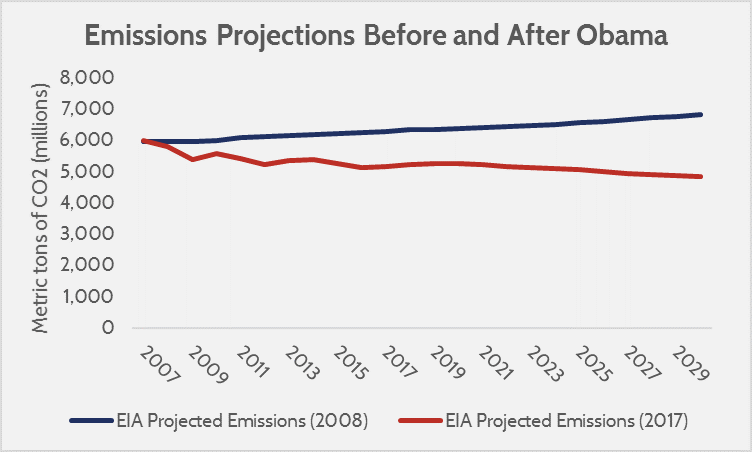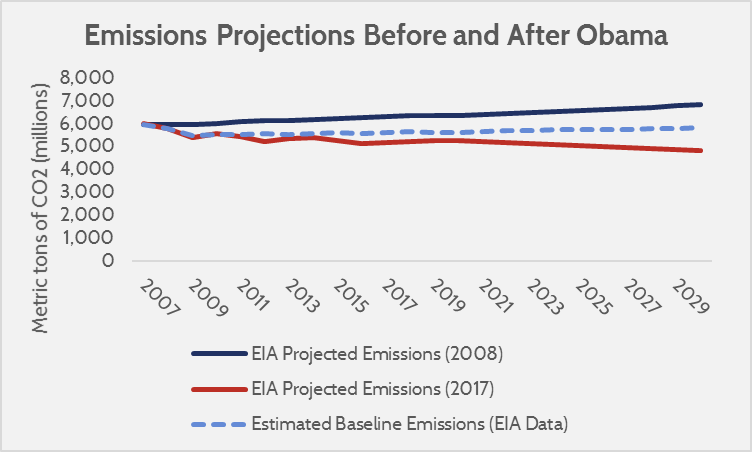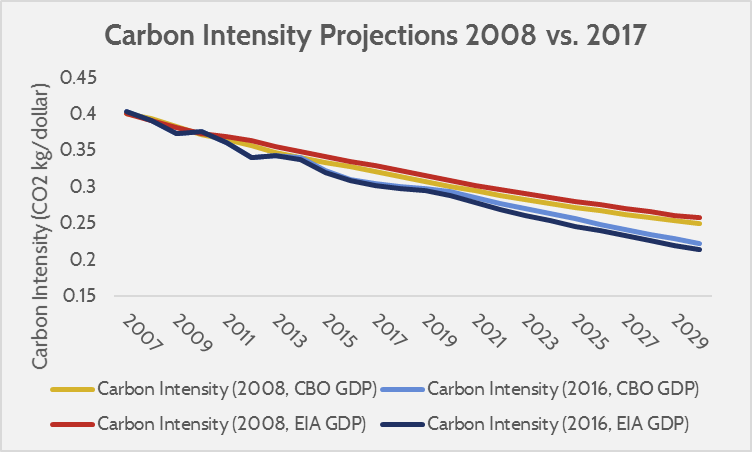Research
January 19, 2017
President Obama’s Environmental Legacy
Summary
- President Obama can claim deep cuts in CO2 emissions relative to baseline projections; about 1 gigaton of CO2 annually (the U.S. emits 5.2 gigatons of CO2 annually).
- Although total emissions have gone down, the economy is not much cleaner now per dollar of production than it was expected to become naturally.
- When using moderate economic projections, expected emissions cuts weaken significantly, and when coupled with $457 billion of regulatory burdens creates an abatement price of over $65 per ton (well above regulator’s claimed benefit of $36 per ton).
Introduction
President Obama will be remembered for his environmental legacy, particularly with respect to cutting emissions. He and his administration negotiated the Paris Agreement, he advocated for extending renewable energy subsidies, and he finalized numerous rules intended to cut greenhouse gas (GHG) emissions. His command and control approach to curbing GHG emissions via regulation that circumvents Congress has been both praised and criticized. Irrespective of one’s belief of methodology, there is now a need for hindsight on Obama’s policies.
The Data on the Surface
The simplest and most common method of comparing emissions is to look at the absolute values, and compare projections before and after his tenure. What was the trend of emissions before he took office, and what is the trend as he leaves? The graph below shows the Energy Information Administration’s (EIA) projected emissions in 2008, and their most recent 2016 projections.
 Source: EIA Energy Related CO2 Emissions Projections, 2008 and 2017 Annual Energy Outlook.
Source: EIA Energy Related CO2 Emissions Projections, 2008 and 2017 Annual Energy Outlook.
At a glance, it looks as though there were deep emission cuts. Annual energy related CO2 emissions in 2008 were projected to climb to 6.85 billion metric tons, but more recently they are expected to drop to around 4.85 billion metric tons (including the Clean Power Plan). However, this does not mean that Obama’s legacy is cutting emissions by 2 billion metric tons annually.
Emissions, as an absolute value, are a dependent variable, and they change for reasons other than just policy. The biggest driver of emissions is the economy, which was amid a severe recession right when President Obama took office. The reason the 2008 emissions projections are so high is because of the projected high growth of the economy, which did not occur.
When using a measure of emissions that ignores business cycles, such as carbon intensity (carbon emissions for each dollar’s worth of production), the outlook is quite different.
Source: EIA 2008 and 2017 AEO reports, and AAF calculations.
The graph above includes a third line, which is the projected annual emissions with the same projected carbon intensity improvements as in 2008. This is referred to as a “baseline,” and any emissions cuts that President Obama can claim credit for are measured from the delta between new projections and the baseline.
The baseline is 1 billion metric tons of CO2 lower than the 2008 projection, wiping out about half of the emissions cuts. The EIA’s 2017 projected emissions are 974 million metric tons below the baseline, which is very close to the reductions claimed by regulators, which is 1.08 billion metric tons annually.
AAF examined all finalized EPA and DOE rules that estimated both annual costs and an associated GHG reduction. This includes headline-grabbers like the Clean Power Plan, all the way down to efficiency standards for vending machines. The annual burdens of these rules are $38.56 billion, and the projected annual emission reductions are approximately 1.12 billion tons annual CO2 equivalent (of which 1.08 billion is CO2). This results in an average per-ton abatement cost of $34.44.
Since the federal government assumes a benefit from carbon abatement of $36 per ton (the social cost of carbon), a $34.44/ton abatement cost makes the regulations just barely net beneficial on paper. However, that estimate is likely optimistic, since the EIA’s projected economic growth is higher than other governmental organizations expect.
Estimated Growth Rates Affect Projected Carbon Intensity
A measure of carbon intensity is more useful for retrospective analysis than carbon emissions projections. If emissions decline, but the rate of carbon intensity change is constant, then the emissions cuts are a product of declining economic growth rather than policy success. Economic growth is important not just for offering greater flexibility in addressing environmental issues, but also because as the economy grows, it naturally becomes more energy efficient. Placing greater value on environmental conservation, more of the economy being comprised of low-carbon industries (services, technology, etc.), and more potential value from energy efficiency as energy consumption rises, all fuel a decline in carbon intensity as the economy grows.
Since carbon intensity declines as the economy grows, but climate policies have economic impacts which reduce growth, there is an inevitable tradeoff. In theory, a policy that has small emissions cuts but large economic burdens could weaken the rate of carbon intensity improvements, resulting in a dirtier (and smaller) economy than otherwise would have occurred, even if the estimated total emissions are declining. Thus, carbon intensity is an equally important measure of climate policy as total carbon emissions.
When assessing President Obama’s climate legacy, carbon intensity paints a different story than looking only at emissions. The projected emissions baseline and carbon intensity relies on optimistic levels of growth (2.1 percent) compared to the non-partisan Congressional Budget Office (CBO) estimates (1.9-2.0 percent). This exaggerates the anticipated improvements to carbon intensity. AAF calculated an alternative carbon intensity projection, which uses the CBO’s projected GDP rather than the EIA’s projection.
Source: EIA AEO (2008, 2017), CBO 10-Year Economic Projection (2008, 2016), AAF Calculations.
When using CBO economic projections, there is a considerable narrowing of the delta between the projected carbon intensity before and after President Obama’s policies. The weaker economic growth rate also depresses the baseline. Below is a new emissions baseline based on the CBO’s GDP projections.
 Source: EIA AEO (2008, 2017), CBO 10-Year Economic Projection (2008, 2016), AAF Calculations.
Source: EIA AEO (2008, 2017), CBO 10-Year Economic Projection (2008, 2016), AAF Calculations.
Using CBO data, the baseline projection of emissions without policy changes is far closer to the EIA’s emissions projections that include President Obama’s climate policy changes. This is for two reasons: the CBO projects a weaker economy than the EIA (meaning lower emissions) in 2017, and the CBO’s GDP projections were higher than the EIA’s in 2008, resulting in a more optimistic rate of carbon intensity improvement for the baseline. This new baseline projects about 5.43 billion metric tons of CO2 emissions annually, which is only 581 million tons above the EIA’s emissions projection (which include the Clean Power Plan, a regulation that was stayed by the Supreme Court).
If this new emissions baseline was applied to the regulatory burdens, then the abatement cost per ton would rise to over $65. Under such a baseline, it would be nearly impossible for regulators to defend their rules as being net beneficial to the economy. This abatement price would also be well above the expected abatement costs for most emissions.
As a consideration, it should be kept in mind that if the EIA revised their economic projection down, they would also revise their emissions downward. In lay terms, the true amount of annual emissions reductions that can be accredited to policy should be somewhere between 581 million and 1 billion tons.
Interpretation of Data
The claimed emissions cuts from the administration may be an overestimation. Those claims rely on a higher level of economic growth than other economic projections, and lead to an assumption of greatly improving carbon intensity in the economy. Using more modest estimates of growth show that carbon intensity is not improving much faster than it would have without regulation, meaning the slowing economy may be a bigger driver in emissions cuts than regulators claim. These results are also consistent with recent research from the Breakthrough Institute, which found policies that cut total emissions usually did not improve emissions relative to economic output. In lay terms, regulators are claiming that the tradeoff between economic costs and emissions cuts is more fruitful than the data supports.
While the total emissions reductions may be uncertain, what is more concrete is the $457 billion in regulatory burdens focused on greenhouse gases (GHG). How is it possible that such concerted effort could be put towards GHG abatement, and the cuts not be realized as envisioned? There are a few reasons. First, is that command and control strategies—like President Obama’s regulations—are not very cost-effective abatement tools. They do not efficiently target the least-cost methods of abatement, and as such do not uniformly capture all low-cost abatement opportunities. Secondly, there have been so many regulations and such large burdens that they are having an impact on economic growth, which is slowing the rate of carbon intensity improvement from economic growth and detracting from the predicted improvements from regulators. Thirdly, President Obama did not pursue a uniformly clean energy agenda; clean energy sources like nuclear power and hydroelectricity had to deal with increasing amounts of red tape, while wind and solar power received preference for subsidies and treatment under the Clean Power Plan.
Conclusion
President Obama took extensive executive action to regulate emissions, but his claimed reductions are attributable mostly to a weak economy. For his administration’s claimed emissions cuts to be accurate, the carbon intensity would have to be improving at a much faster rate than the data supports. At AAF’s predicted carbon intensity rate, each ton of abatement has cost roughly $65 per ton—almost double the claimed $36 per ton benefit. This is consistent with established expectations, which find that command and control strategies to abatement are only cost-effective if the projected climate impacts are exceptionally high. The upshot is that a purely regulatory approach to climate issues has been tried, has not been very effective, and is a testament to the need for smarter policy that effectively balances costs and benefits.













